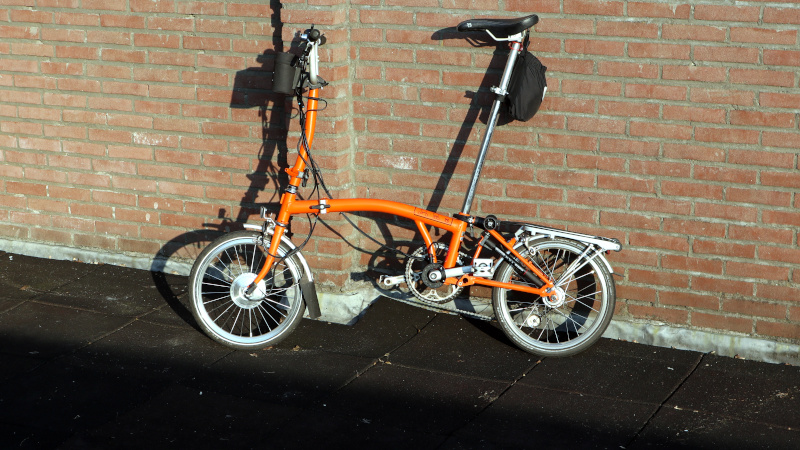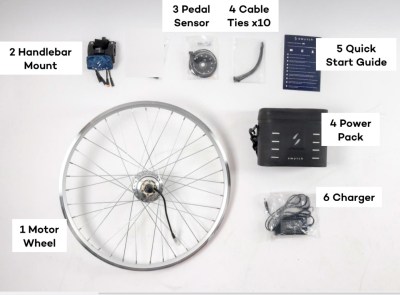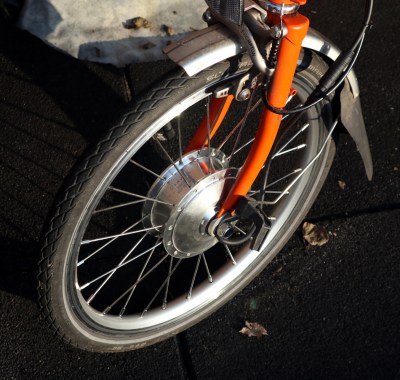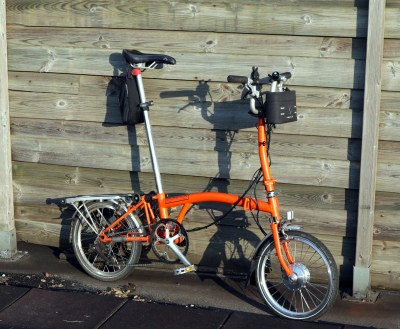
A decade ago I was lucky enough to work for an employer that offered a bicycle loan scheme to its employees, and I took the opportunity to spend on a Brompton folding bike. This London-made machine is probably one of the more efficiently folding cycles on the market, and has the useful feature of being practical for longer journeys rather than just a quick run from the train. A 3-speed hub gearbox is fine for unhurried touring, but sadly my little folder has always been a bit of a pain on the hills. Thus around the start of the pandemic I splashed out again and bought a Swytch electric upgrade kit for it, and after a few logistical and life upheavals I’ve finally fitted it to the bike. I’ve ridden a few electric bikes but never had my own, so it’s time to sit down and analyse the experience. Is an electric bike something you should have, or not?
A Box Of Bits Becomes An Electric Bike

Swytch sell their kits via crowdfunding rounds, so I’d been on a waiting list for a while and got an early-bird price on my kit. It took quite a while to arrive, much longer than the expected time in mid-2020 because of the pandemic, finally being delivered some time in February last year. It came in a modestly-sized cardboard carton which would be an easy carry on the Brompton’s luggage rack, containing neatly packed a new front wheel with motor, as well as the battery and all sundry parts.
Fitting the kit shouldn’t stretch the capabilities of a Hackaday reader, with probably the trickiest part being the positioning of a Hall-effect sensor near the crank. The kit works by providing a motor assist when you pedal, so part of it is a set of magnets on a plastic disk with various attachments for different cranks and pedal sets. The Brompton front wheel is removed and its tyre and tube transferred to the Swytch one, which is then put on the bike. Once the magnet disk and Hall sensor are attached, the cables follow the existing ones and emerge at the handlebars where a sturdy bracket for the battery box is fitted.
The Swytch Kit First Impressions

The battery also contains the electronics and motor driver, and provisions for brake sensors and a hand throttle, which I had not ordered. My kit is painfully UK road legal with a pedal sensor, software-limited 250 W power, and around 15 mph top speed. I could have ordered it with no limits and all the extra toys to make it more like a small electric motorcycle, but even though I can remove the software limit I can’t negate the risk of a roadside inspection and fine if I did so.
Swytch offer two battery packs in 30 km and 50 km range sizes, and of those I bought the larger one. After charging it up, I turned it on and clipped it in the bracket. Ready to test a new toy on the concrete apron behind my hackerspace!
The Swytch battery pack comes with some controls on the top, the main function of which is to vary the amount of electrical assistance. This is best described in terms of who’s in charge; at maximum assistance it’s the bike that’s doing the pulling and all you need to do is move the pedals, while at the minimum it’s a handy aid that smooths out the effort and makes cycling a less strenuous exercise while leaving you definitely in control.

There’s one minor snag: in some conditions the motor vibrates instead of starting smoothly. From my experience with AC motors for Hacky Racers and other machines I am guessing that this stems from the motor feedback to the controller being via back EMF sensing rather than Hall effect devices, so what I’m seeing is a temporary loss of that feedback. It’s usually quickly cured by stopping pedaling and restarting after the motor has cut out, something that doesn’t significantly impede progress.
I’ve used the bike a lot for general riding, but I’ve also set out to work out the real-world achievable range with a few longer cross-country test rides with it on low power mode to assist rather than replace my cycling. As expected, I never managed to crack 50 km, but I came pretty close.
My routes weren’t ideal with a few inclines and on one of them some stiff headwinds on the day I did it, but even so I achieved between 40 km and 45 km, which I count to be not too bad for a 50 km battery. Once the power is exhausted, there’s a perceptible drag from the motor, but it doesn’t render the bike unrideable.
So What’s An Electric Bike Like To Use?
The description of a Swytch kit aside, it’s time for some more general impressions about electric bikes based on a while using an electric Brompton as daily transport. There’s even a handling angle, as the bike is now an all-wheel-drive vehicle. How does it change the riding experience?

The first impression of an electric daily rider might seem obvious in that it’s now much faster. I could reach the mid-teens speeds before but only with some effort, now they’re within reach any time I want. This is great for getting from A to B, but I’m also acutely aware that I can get into trouble a lot more quickly. Oddly I have found myself riding much more cautiously, particularly in town where there are pedestrians and traffic.
With electric power at the front and pedal power at the rear, the bike is now a two-wheel-drive vehicle. Two-wheel-drive motorcycles are so vanishingly rare as to be restricted to a very few small-production models, but courtesy of my friend Russ’s electric minimoto conversion I was given the rare opportunity to ride one at EMF 2018.
It was notably sure-footed on the gravel roads of the EMF campsite, but suffered from a pants-filling moment on start-up as the front wheel would spin while the rear had traction. By contrast, the momentary delay afforded by the Swytch pedal sensor system was enough to ensure that the Brompton was moving before power came to the front wheel, ensuring that even on loose surfaces there was never any unexpected wheelspin.
The resulting two-wheel drive makes a noticeable difference on surfaces such as grass and loose gravel that would normally challenge the Brompton, and when giving it a spirited ride on tarmac the extra traction can get me out of trouble. It’s dangerous to become addicted to fast tight turns with rear wheel slide, though, because when the inevitable happens and the front wheel lacks the purchase to pull me out of it, I can see that the results could be painful. The sight of a middle-aged woman exorcising her teenage BMX dreams on a folding commuter bike must be amusing to watch, but at least I was having fun.
So, should you go electric with your bicycle, or is it all a bit pointless? After all it’s not entirely cheap, and you have to pay for a bike on top. The answer is that if you’re fit or only ever riding short distances, then perhaps it’s not essential. But if you ride medium distances, and perhaps most importantly if you ride to places for which it’s important not to arrive a sweaty mess, then the electric bike is a worthwhile upgrade. The Brompton’s not my main bike, so I use it for trips where I need to take it on a train or in a car, and I value the Swytch kit for the extra range it gives me while keeping me from looking over-exerted.
Oddly there’s a use case for which an electric bike would be unsuitable, namely longer distance riding. The thought of riding for more than a short distance against the extra drag of the motor isn’t appealing, so the Brompton’s now a bike with an effective 50 km maximum range. I frequently use my everyday bike for longer trips, but for your only bike it’s worth bearing in mind.
Electric bikes aren’t for everyone, but perhaps is 2022 the time to give them a try?
Converting Your Bike To Electric: Why You Should, And When You Shouldn’t
Source: Manila Flash Report
0 Comments